Issue:
September 2023
Shunkaen bonsai nursery showcases craftsmanship as art
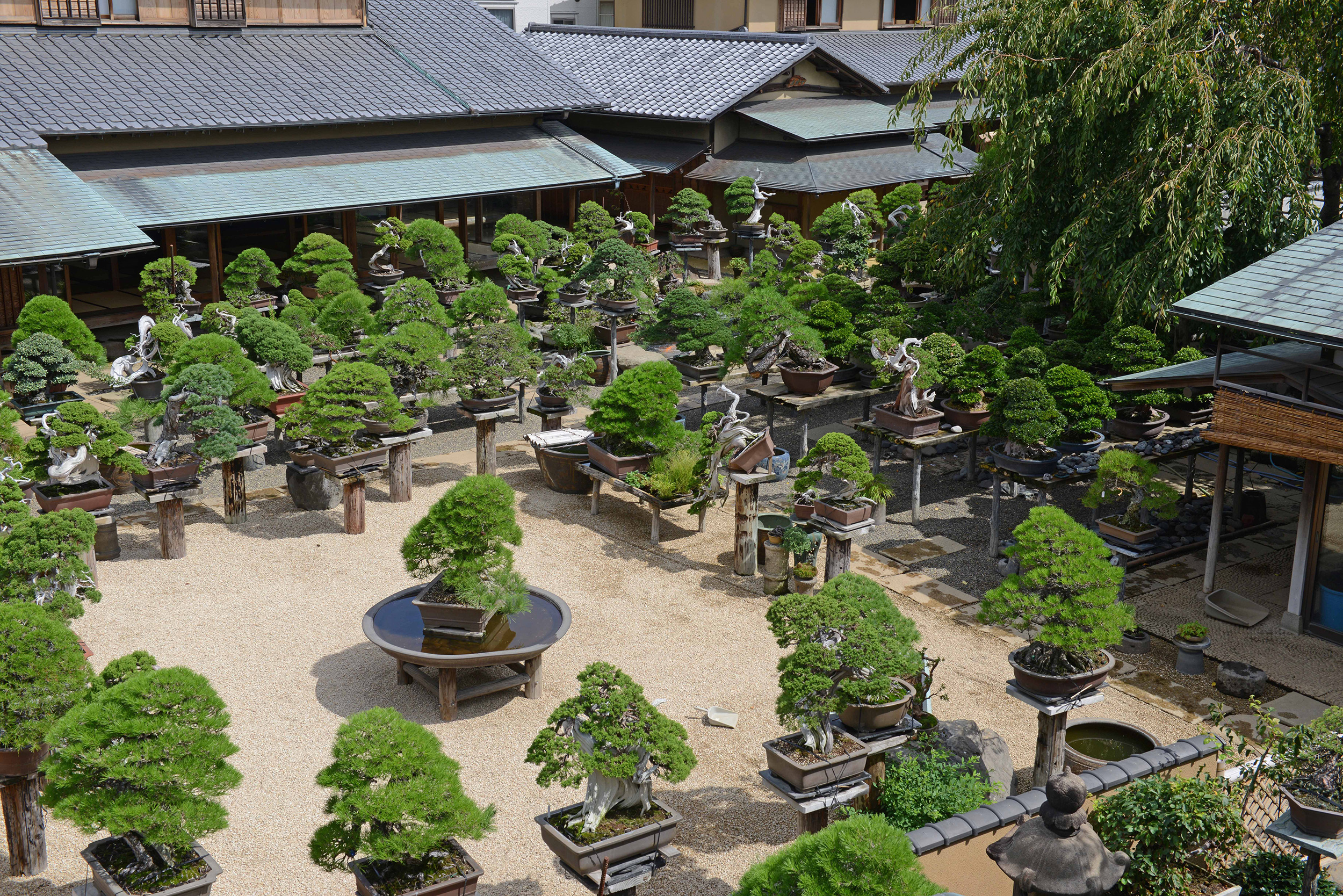
Trellises are set out so that visitors can walk between them and inspect the trees at close quarters. © Stephen Mansfield
“You feel the brevity of your own life,” a bonsai nursery worker once told me, “when you stand in front of a potted tree that is half a millennium old.” I’m experiencing a similar sensation now, standing in front of a 500-year-old miniature pine, marveling at the fact that a string of carers has stepped forward over the centuries to respectfully tend to its needs. It turns out that this is one of the most valued bonsai specimens at Shunkaen – a fine example of rarity by association, the tree descending down the ages from its original owner, the Shogun Iemitsu Tokugawa.
One of the foremost bonsai centers in Japan with over 2,000 specimens, the name Shunkaen suggests a garden, and this is the initial impression the visitor receives stepping from the pavement outside the walled enclosure onto black nachiguro pebbles embedded in mortar, a traditional Japanese garden touch, signaling the transition from the outer to inner zone. Strolling through the dark wooden gate, the tones change to green as your eyes focus on trays of plants placed on single rows of trellis tables or in massed tiers.
Shunkaen Bonsai Museum, located in Nihori in eastern Tokyo, is the life work of bonsai master Kunio Kobayashi. The offspring of two interesting branches of devotion – his grandfather was a priest, his father a florist – Kobayashi has compared the art of bonsai to Japanese ink painting, the powerful trunks and branch forms akin to the monochrome lines created by brush strokes. What sets bonsai cultivation apart, however, is that it is a collaboration between man and nature, moderated by the slow passage of time.
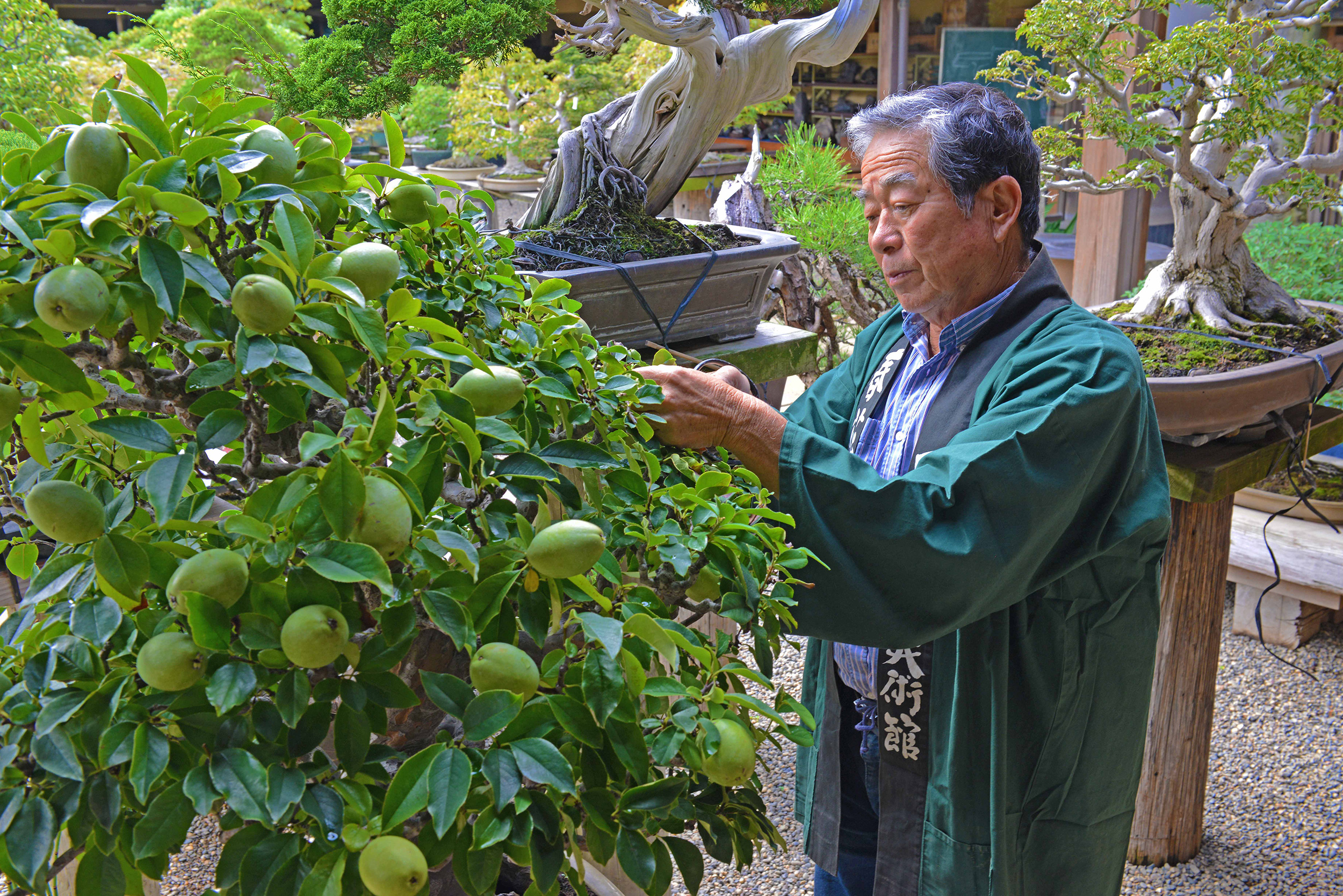
Kunio Kobayashi, trimming a fruit specimen at his nursery, Shunkaen. © Stephen Mansfield
Originating in the royal courts of ancient India, bonsai cultivation is more strongly associated with China, where it was popularized and cultivated to a level akin to an art. The bon of the name in Japanese means pot, or tray, while sai stands for the plant. Well suited to space-pinched Japan, bonsai potted trees in China were valued for their aesthetic qualities. It was inevitable that the practice would be modified and refined in Japan when it arrived here in the 14th century. Japanese agriculture and horticulture are conducted within relatively confined spaces, the restrictions requiring self-discipline, perseverance and manual dexterity. They also happen to be requisite qualities in the cultivation and maintenance of potted trees. The cultivation of bonsai also demands large reserves of patience.
The nomenclature that accompanies the practice is somewhat complex, but easily learned through contact with bonsai representing certain growth types. The ishi-zuki tree, for example, is quickly recognized for the way its roots entrap the rocks at the base of the plant. Sabakan are quickly spotted because of the way that the bark has perished, leaving areas of light-colored, exposed bough. The vision of a tree that is both withered and alive is said to be an embodiment of the Buddhist concept of impermanence and the dual nature of reality. The design possibilities are equally manifold, and include chokkan, an erect trunk, kengai, a tree overhanging a cliff, and fukinagashi, in which the desired effect is to suggest a tree being battered by the wind. It’s all very lyrical and representational, a lot like classic Japanese poetry. Such symbolism may be pleasing, but ultimately, nurseries are serious working areas. This is apparent when casting an eye over Shunkaen’s cluttered work benches. In the congested stock rooms of nurseries like this, you will come across shelves of trays, stands and pots. Many of the ceramic dishes are purely functional, but others, of Japanese and Chinese origin, are of evident aesthetic quality, and will have been acquired at auctions or through bonsai networks.
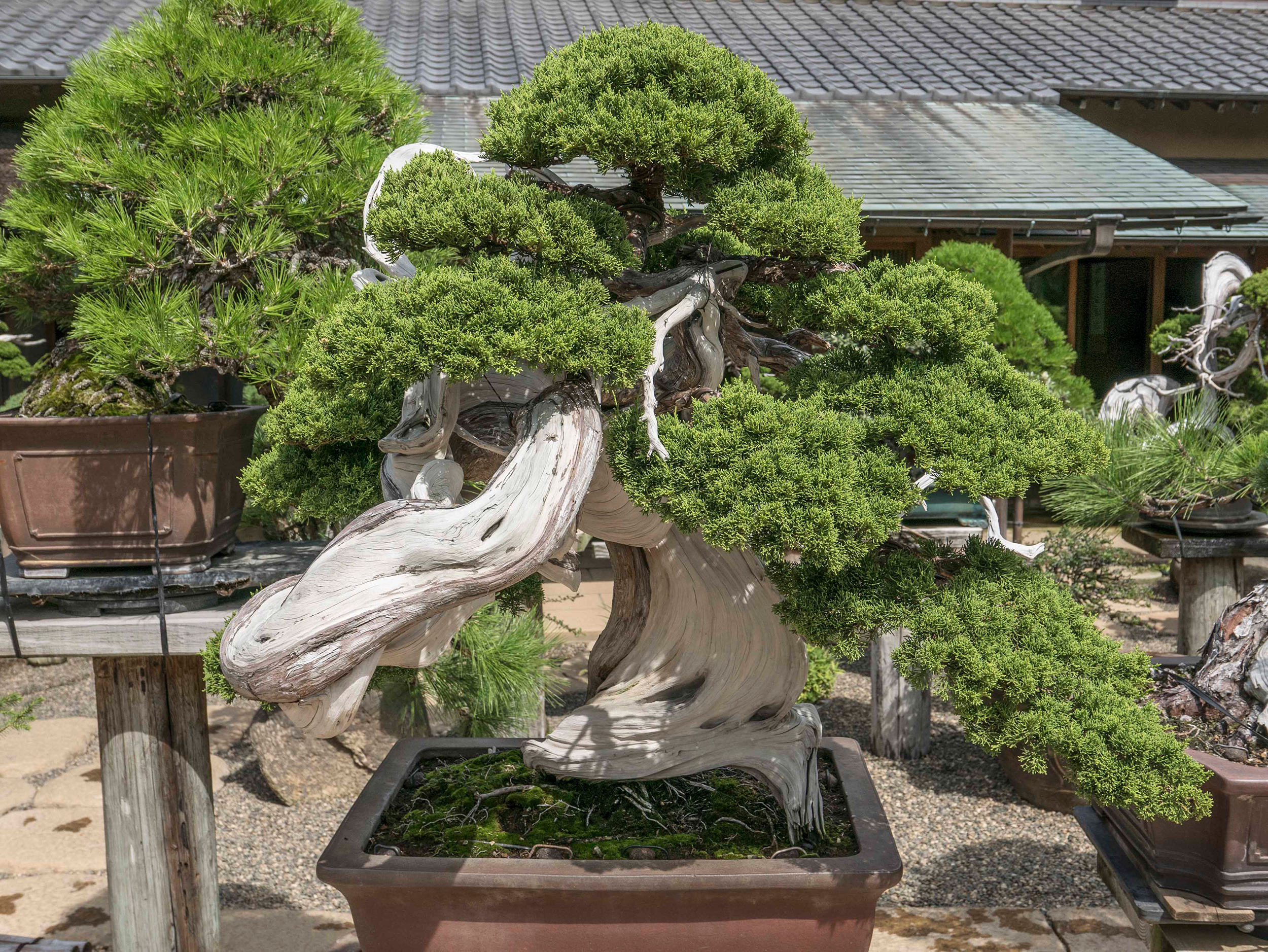
The care of bonsai depends on the seasons and weather. The last time I visited Shunkaen, staff were busy returning their samples to the outside garden area. A weather report forecasting an approaching typhoon had meant that all the specimens, including the larger, heavier varieties, had to be brought indoors. The sensitivity of the trees to temperature, humidity, moisture and broader climatic influences is what makes them so intriguing, and the work going on within the nursery so engrossing. There is less a feeling of display than of hard work at these places, which are cluttered with pliers, copper wires, clippers and an assortment of other tools.
Besides being work sites, the nursery exhibits pleasing, rustic touches consistent with Japanese garden aesthetics. These include stone lanterns, water basins, traditional entrance gates and grass growing between granite flagstones. Kobayashi oversaw the construction of the site’s wooden structures, inner galleries, alcoves and a teahouse, all made of the finest materials. In the polished wood floors, tatami mat rooms, lathered earth and straw walls, granite stepping-stones, sunken roof tiles used as borders, and a curving koetsu-gaki style fence, we enter a refined world, a digest of Japanese garden aesthetics, the ideal ambience for an exhibition of bonsai.
Moss is difficult to grow in the Tokyo area, but Kobayashi has succeeded in cultivating small patches in suitably shaded, well-watered corners of the garden. His attempts at recreating the rustic aesthetic of the forest hermitage, so beloved of the tea garden designers, was less successful. The thatched roofing that characterizes the teahouses and woodland sanctuaries of poets in the Japanese literary tradition were near impossible to recreate in an aerially exposed location like this. When Kobayashi tried, the straw was swiftly stripped off and requisitioned by Tokyo’s crows, gathering nest materials.
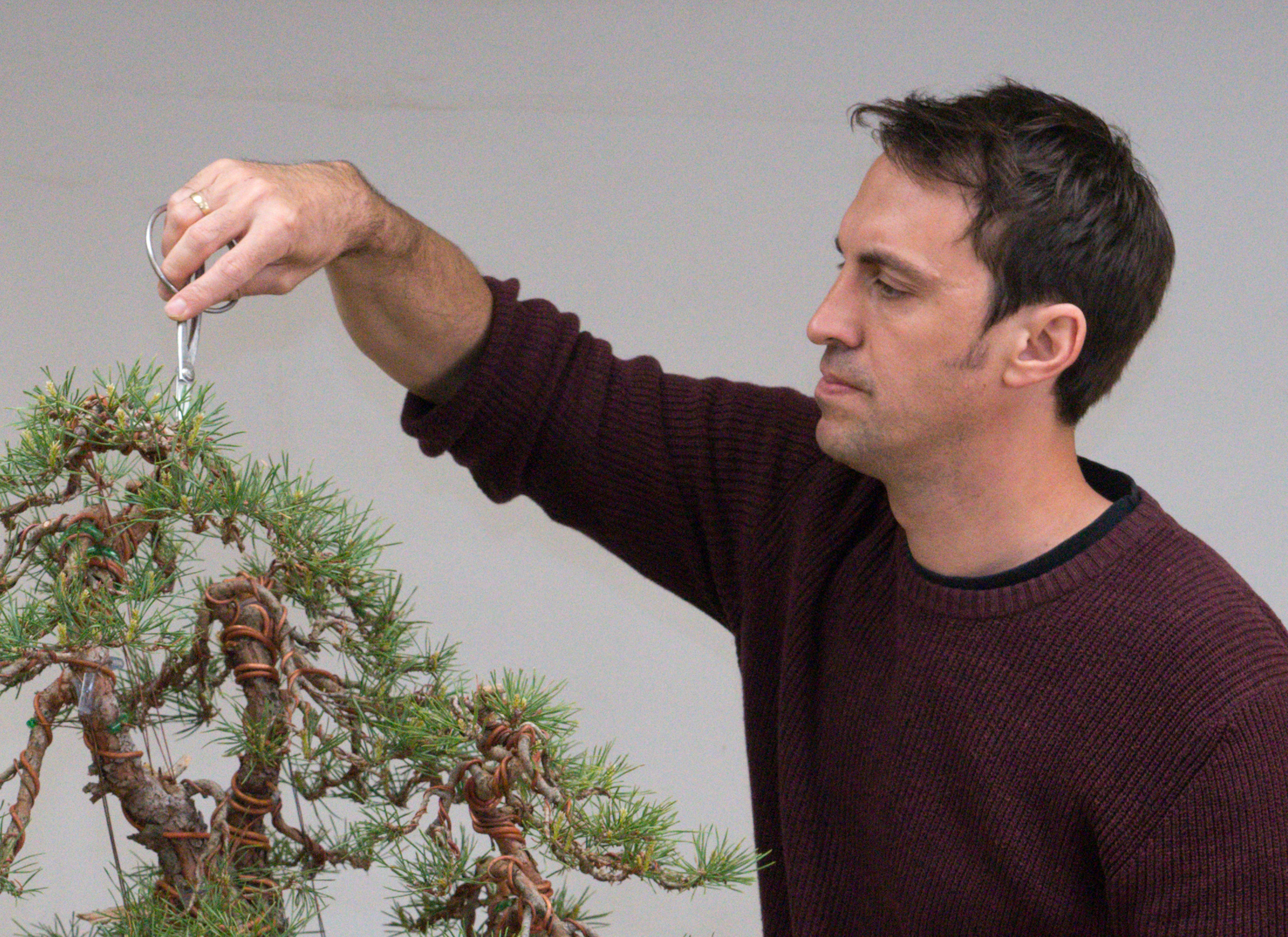
After apprenticing in Japan, Valentin Brose set up a bonsai nursery outside Stuttgart in 2016. © Stephen Mansfield
The traditional route for students wanting to learn bonsai, or indeed to learn any art or craft from a master, was to serve as an apprentice. This was an arduous process, involving long hours and little free time. Trainees, who were expected to live in the master’s home could expect little praise for their efforts. Those who endured, though, received an unparalleled education. That system is still maintained at Shunkaen. A few years ago, I met Valentin Brose, a young German who, serving an apprenticeship here for over three years, working 15-hour days, apparently loved every moment, despite a schedule that allowed for only one day off a month. He is now a successful bonsai practitioner, with his own well-regarded nursery outside Stuttgart. Asked more recently about his time under the tutorship of Kunio Kobayashi, he sees those years as vital, not only in terms of acquiring bonsai techniques and design skills, but in formulating “thinking and approaches, such as interpersonal interaction and respect”.
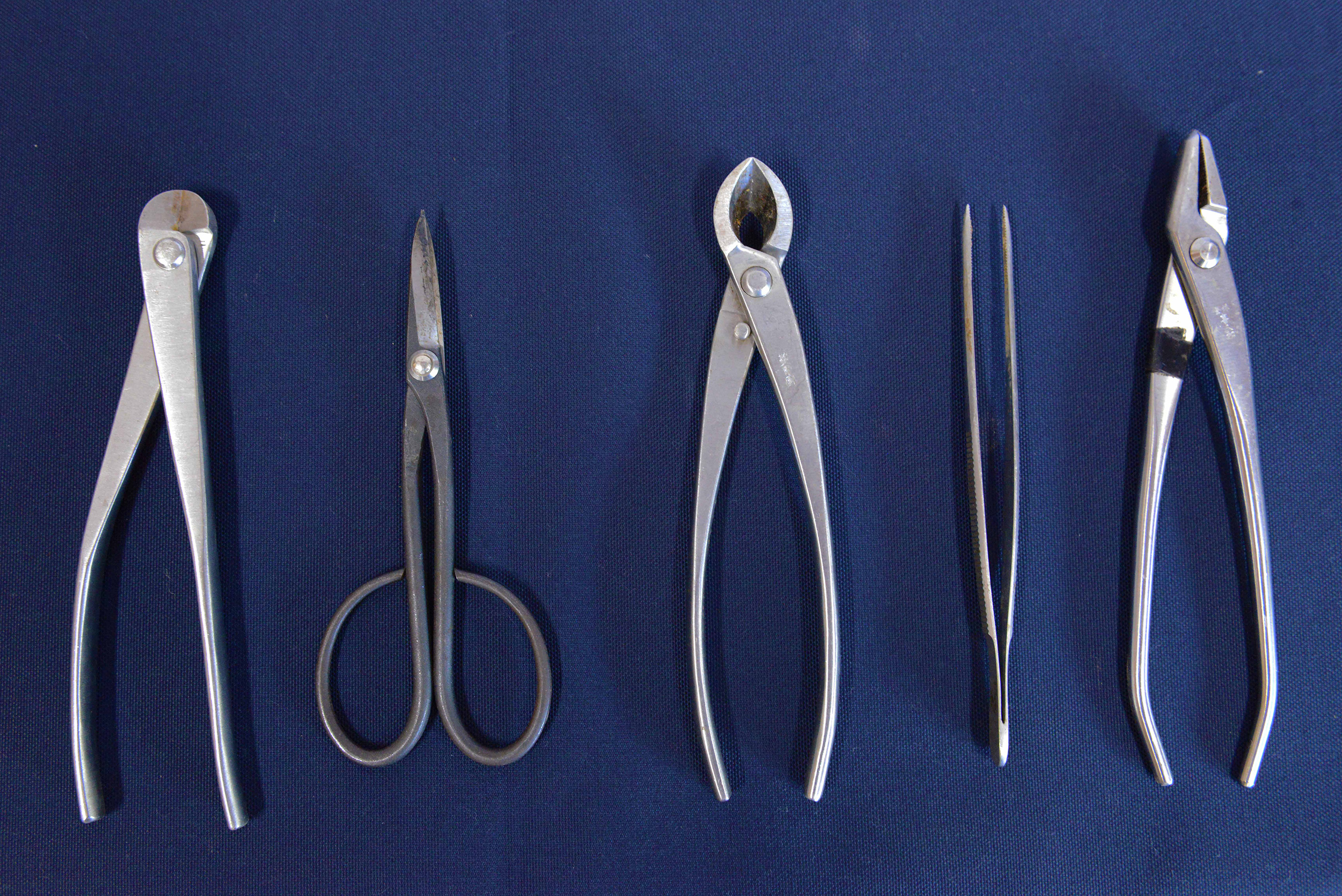
Precision tools for detailed work on bonsai. © Stephen Mansfield
Bonsai cultivation might be termed an art overseen by craftsman. There is, for example, something painterly suggested by bonsai forms, their miniature landscapes, the rocks, moss and crevices evoking Sung Dynasty Chinese canvasses, where hermits, scholar-poets and mystics stand at the edge of precipices or beside thundering waterfalls. In his essay, The Bonsai Master, the English poet James Kirkup, wrote: “Here is an entire landscape in a flat dish: there tiny pines yearn together round a small, weather-beaten stone that suggests a cliff, lean against imaginary skies and legendary bays.” A writer of luminous perception, he was able, while visiting a private bonsai collection in the 1960s, to sense that the dwarf pines he saw there were even more pine-like than the actual full-sized trees, that they were “not just pines; but the concentrated essence of pine nature.”
In all likelihood, the samples Kirkup wrote about are still thriving somewhere today. Witness to vast passages of time, bonsai that are well-maintained will far exceed the life of any human being. It’s a sobering, but rather wonderful thought.
Stephen Mansfield is the author of three books on the Japanese garden, including Japan’s Master Gardens: Lessons in Space & Environment.

